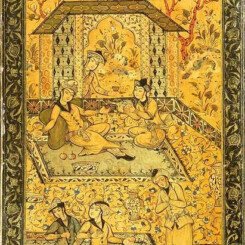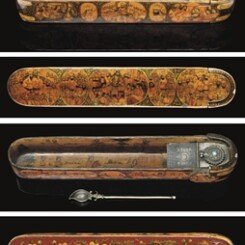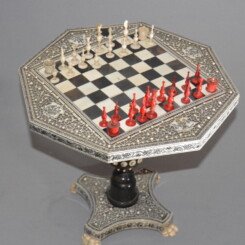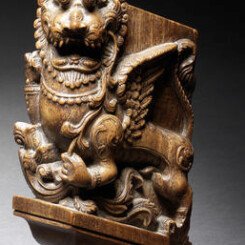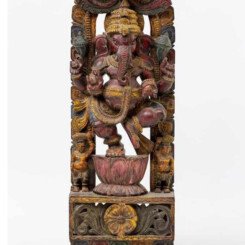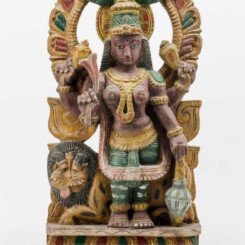Wooden Art Work
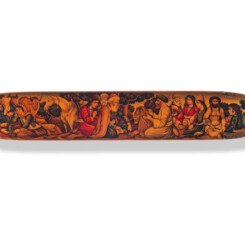
A QAJAR LACQUER PENBOX (QALAMDAN)
PERSIA, SECOND HALF OF THE 19TH CENTURY. With rounded ends and sliding tray, decorated in polychrome and gilt with a shaykh, lion and his followers to the top and further figural scenes to the sides depicting musicians and warriors, the sides of the inner and base with an interlace of vines . 23.2 cm. long
A QAJAR LACQUER PENBOX (QALAMDAN)
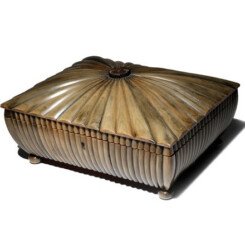
AN INDIAN HORN AND SANDALWOOD BOX
AN INDIAN HORN AND SANDALWOOD BOX 19TH CENTURY. With a hinged cover, the interior containing a removable tray with four compartments, the four square corner compartments with carved wood covers surmounted by knops shaped as flowerheads, with a rectangular hinged panel to the interior of the cover, all raised on four small compressed circular feet, the base with a paper label reading, Size 34 X 26 X 16
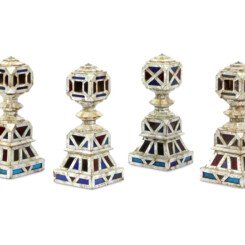
FOUR MOTHER-OF-PEARL AND COLOURED GLASS CHARPAI LEGS
India, 19th century. Of typical shape, each leg resting on a squared flat base rising to a stepped pyramidal and squared structure, with a ringed neck and polygonal hollow head, the exterior completely clad in mother-of-pearl tesserae held in place with now oxidised copper pins, the base and head of each leg filled with foil-backed red and blue-coloured glass sheets, cut in geometric patterns. Size 37.5 cm
FOUR MOTHER-OF-PEARL AND COLOURED GLASS CHARPAI LEGS
India, 19th century. Of typical shape, each leg resting on a squared flat base rising to a stepped pyramidal and squared structure, with a ringed neck and polygonal hollow head, the exterior completely clad in mother-of-pearl tesserae held in place with now oxidised copper pins, the base and head of each leg filled with foil-backed red and blue-coloured glass sheets, cut in geometric patterns. Size 37.5 cm
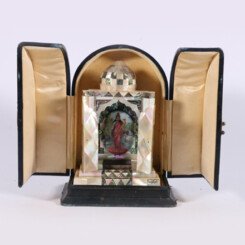
Indian mother of pearl and abalone shell inlaid portable shrine (zushi)
Indian mother of pearl and abalone shell inlaid portable shrine (zushi) in the form of a temple, the doors opening to reveal a porcelain panel depicting a Hindu goddess, perhaps Lakshmi, 15cm tall in fitted travel case., 15 cm
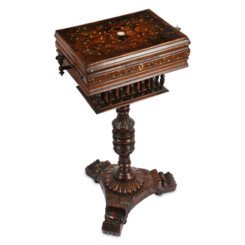
A FINE IVORY AND BONE-INLAID STATIONARY SECRETAIRE
A FINE IVORY AND BONE-INLAID STATIONARY SECRETAIRE, Possibly Gujarat, North-Western India, dated 1842, Of stepped rectangular shape, on a tall bulbous leg resting on a tripod with volute-shaped feet, the balustrade-like base rising to a larger stationary secretaire top, the interior divided in a number of drawers, tool cases and secret compartments with ivory handles, the screwed-in pole securing the table to the leg enhanced with a wooden pommel with an ivory plaque engraved with the 18th-century-designed East India Company balemark, a heart-shaped figure surmounted by the numeral four and containing the initials of the company, the inner part of the lid lined in red velvet, the exterior decorated with bone and ivory marquetry work consisting of vegetal and floral sprays, in the centre an ivory roundel with the name of Lieutenant General H. Gough and the date 1842, 79cm x 36.5cm x 25.5cm.
Provenance: Mitchell's Fine Art Auctioneer & Valuers, Antique and Fine Arts, 27 November 2019, lot 1943.
According to the Encyclopaedia Britannica, Sir Hugh Gough (1779 - 1869), also called Baron Gough (1846–49) or 1st Viscount Gough (from 1849), was an eminent British soldier who played key roles in a series of game-changing wars involving Britain in the first half of the 19th century, such as the Peninsular War (1808 - 1814), the First Opium War (1839 - 1842), and the First and Second Anglo-Sikh Wars (1845 - 46 and 1848 - 49). On 18 June 1841, he was promoted to the rank of Lieutenant General in India and in China ("No. 19989", The London Gazette, 18 June 1841, p. 1583) and in 1842, he commanded the British forces at the Battle of Chapu in May and at the Battle of Chinkiang in July. Upon his return to India after the Treaty of Nanking, he was appointed the title of Baronet on 1 December 1842. It is likely he commissioned this secretaire in India as a commemoration and memorandum of a successful year in his personal and military career. For more information on Sir Gough, please visit the website entry of the Encyclopaedia Britannica: https://www.britannica.com/biography/Hugh-Gough.
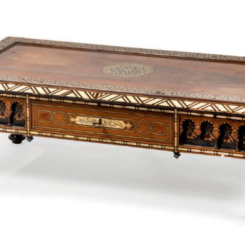
Table basse rectangulaire en bois teinté et noirci marqueté d'os et de nacre à motifs géométriques et de rosaces. La ceinture à arcatures ouvre par un tiroir en façade et deux tiroirs latéraux. Pieds fuselés. (Accidents aux pieds)
Travail oriental, XXe siècle.
H. 36 cm. L. 122 cm. P. 61 cm.
Travail oriental, XXe siècle.
H. 36 cm. L. 122 cm. P. 61 cm.
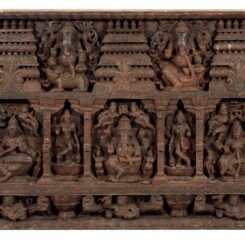
Wooden large Panel
Bravely carved with Goddess, with central figure of Lord Ganesh. 19th Century South Indian.
Size 200 cm X 90 cm
Size 200 cm X 90 cm

